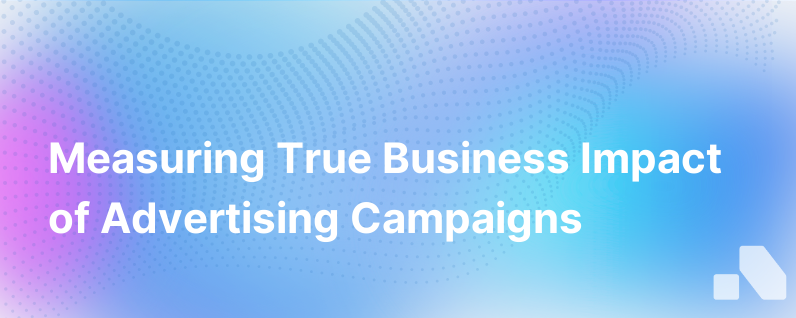
In today's vast and complex digital landscape, advertising is a critical component of a brand's success. As businesses allocate substantial budgets to different advertising channels, the stakes to measure and understand the true impact of these advertisements on the business have never been higher. Accurately gauging this impact helps optimize strategies, ensuring every advertising dollar is well spent.
This deep dive into measuring the true impact of advertising will cover pivotal approaches that every business, regardless of size or industry, can utilize to ensure that their advertising efforts aren't just shots in the dark but are, in fact, strategic investments driving tangible results.
Understanding the Baseline: Setting Sail with Data
The journey of measurement begins with an understanding of your baseline – where your business currently stands before the advertising occurs. This baseline can be established through a series of initial analyses:
- Historical Performance Data: Analyzing sales volume, website traffic, engagement rates, and other potential success indicators from before the advertising campaign gives a picture of the business's organic growth pattern.
- Consumer Research: Knowledge about the target audience's behavior, preferences, and purchasing patterns also forms the foundation for understanding how advertising may shift their actions.
Defining KPIs: Charting the Course
Key performance indicators (KPIs) serve as lighthouses guiding the assessment journey. They must be SMART: Specific, Measurable, Achievable, Relevant, and Time-Bound. For advertising, they might include metrics like:
- Return on Advertising Spend (ROAS): Measures gross revenue generated for every dollar spent on advertising.
- Customer Acquisition Cost (CAC): The cost incurred to acquire a new customer, offering insight into the efficiency of advertising efforts.
- Brand Awareness and Perception: Might be quantified through surveys pre- and post-campaign to gauge shifts in recognition and sentiment.
- Purchase Intent: Changes in how likely an audience is to purchase after being exposed to advertising, which is often captured through consumer surveys.
- Conversion Rates: The percentage of ad viewers who complete a desired action.
Attribution Models: Navigating Through Fogs of Data
One of the murkiest aspects of measuring the true impact of advertising is attribution. Various models from single-touch (like first-click or last-click) to multi-touch (like linear or time-decay) can be used to ascertain which ads get credit for conversions. Evolving toward a multi-touch attribution model generally provides a more holistic view of an ad's contribution along the customer journey.
Incrementality Testing: Uncovering Treasure in the Data Sea
Incrementality tests, such as A/B testing or geo testing, compare the behavior of a group exposed to ads with a control group that hasn’t been exposed. This type of testing is crucial for understanding whether changes in consumer behavior can be attributed directly to advertising.
Long-term Value: Diving Deeper Than Surface Currents
While immediate sales and conversions are often the focus after a campaign, understanding the long-term value of advertising is crucial. Long-term analysis might consider:
- Customer Lifetime Value (CLV): Predicting net profit attributed to the entire future relationship with a customer.
- Brand Equity: Difficult to measure, but vital in understanding how advertising affects consumer perception and loyalty over time.
Leveraging Technology: Navigational Aids in a Digital Voyage
With mountains of data to process, leveraging sophisticated tools is a necessity. AI and machine learning platforms can decipher complex patterns and contribute to predictive modeling, giving businesses an edge in anticipating advertising outcomes.
Post-Campaign Analysis: Anchoring in the Port of Perspective
Post-campaign analysis should be as comprehensive as possible. You should review the performance against KPIs and distill insights that could optimize future campaigns. Some useful analyses include:
- Media Mix Modeling (MMM): Helps understand the impact of various advertising channels and optimize the media spend.
- Cohort Analysis: Examines the behaviors of similarly grouped individuals over a period, understanding the impact on different segments.
- Path Analysis: Provides insight into the customer journey and the various touchpoints before a conversion.
Common Pitfalls: Avoiding the Sirens of Simplification
Measuring advertising’s impact has common pitfalls:
- Over-reliance on Last-Click Attribution: This ignores the complexity of the customer journey.
- Ignoring External Factors: Market trends, seasonal effects, and competitors’ actions can all influence advertising effectiveness.
- Short-term Focus: Mistakenly valuing immediate results over long-term benefits can lead to scaling the wrong strategies.
Mitigating Confounders: Sailing against Headwinds
Businesses must acknowledge and account for external confounders that could skew measurements:
- Sales and Promotions: These can artificially inflate the perceived impact of advertising.
- Market Conditions: Be it a recession or a boom, economic conditions profoundly impact consumer spending and thus advertising effectiveness.
- Consumer Trends: Shifts in consumer behavior, often outside the control of advertising, must be factored in.
Conclusion: The True North of Advertising Measurement
Ultimately, the true impact of advertising isn’t simply about whether sales increased during a campaign period. It’s about understanding the nuances of how and why your advertising influences consumer behavior, both in the short term and over the long haul, and using that information to refine and enhance future strategies. A rigorous, comprehensive approach to measurement, driven by robust data analysis and technology, provides the most reliable compass to guide businesses on their voyage to successful advertising.